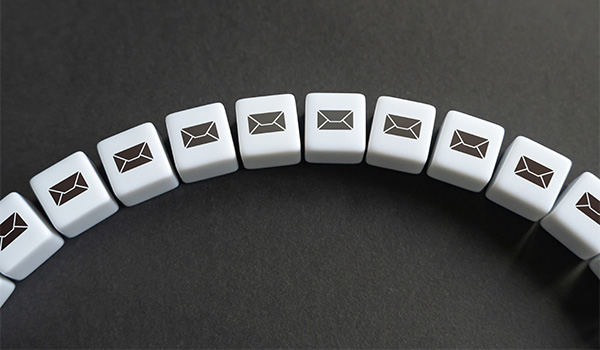Top 5 Types of Direct Mail Lists and How They Work
December 23rd, 2023
7 min read

Before each direct mail campaign, you might find yourself wondering what kind of list you should use. Who would be the best people to reach, and how many of them exist in your region? Which lists make the most sense for each product, service, event or sale notification?
If you’re just getting started with direct mail, you may not have known there even were many list types to consider. But it doesn’t have to be a source of added stress. In fact, selecting the right mail list can help to direct your campaign and get it into the right hands with less effort on your part.
Here at Integra, we’ve been guiding marketers and CEOs just like yourself through the list selection and purchase process for nearly two decades. We work exclusively with mail list providers who stay up-to-date with current trends and keep their data up-to-date with current events, from moves and deaths to business closures and new openings in each region.
You may be thinking, “I already have a company that can get me the list data I need,” and that’s perfectly fine. We’re happy just to steer you in the right direction so that you know exactly what to ask for or seek out when it’s time to start mailing.
In this article, we’ll deep dive into the five most common mail lists for direct mail campaigns, explaining how each one works and which consumers it targets. We’ll also cover the best situations in which to use each list, and when each might not be the right fit.
1. House List
Arguably the most common type of list — and one that most businesses have just by nature of running a business — is the house list. If you have any kind of customer base built up, you probably have a list of people who have already shown interest in your company. If you’ve collected their addresses or enough information to get their addresses, now might be the time to pull out the handy-dandy house list.
At some point in time, each customer on your house list has visited your location, browsed your website, purchased something from you or filled out a contact form of some sort. You don’t have to guess at whether they’re interested in the type of product or service you sell, because they’ve already done that legwork for you.
Good Fit
One of the best things about a house list is that it comes with little risk. The people on your list are there because they’ve shown genuine interest in your offerings or been a buyer in the past. Even if they’ve dropped off in engagement, they’re unlikely to be annoyed by your communication.
When you do get in touch with these customers via a direct mail campaign, make sure you actually have something to offer. You could reach out just to remind them you exist, but you’re more likely to drum up interest and show that you value their time if you emphasize:
- New items in your product line that they might be interested in
- Extra services that you recently started offering
- Events you’ll be hosting or attending in the near future
- Upcoming discounts and sales on popular items
Bad Fit
First, a word of warning: If you’ve been in business for a significant stretch and haven’t cleaned up your contact data for years, the house list may not be the best call for you. You’re likely to end up wasting valuable marketing dollars on undeliverable mail with a house list.
What are the chances that, say, 30 percent of your client base has changed homes, gone out of business or moved to a whole new state or country? The longer it’s been since you’ve checked your list for accuracy, the more likely you’re sending to these places as well as duplicate addresses you’ve acquired over time.
2. Opt-In List
In the best possible way, this one is a no-brainer. It’s always a good idea to utilize inbound marketing in any instances where you can choose that over outbound, which often feels like spam to potential customers. Give them a chance to sign up as well as a way to opt out if their needs or interests have changed, and there’s next to no chance you’ll be reaching customers who don’t have a vested interest in your products or services.
With an opt-in list, you’ve given people — could be in-person visitors, online traffic or attendees of a trade show you presented at — the option to sign up for direct mail from your business.
Good Fit
If you prefer a fairly non-aggressive approach to marketing, the opt-in list is a great way to progress. You won't be sending anything to anybody without their express consent, which means you can rest easy knowing the vast majority of recipients will be happy — not annoyed — about your correspondence.
Bad Fit
The most obvious caveat with opt-in lists is that you need to have an opt-in process. If you've never given customers the option to opt in and receive your direct mail marketing, you won't have a list to begin with. Step one: Decide what type of materials you plan to send out and where your opt-in request has the best chance of garnering interest.
Another, less obvious factor that might make you a bad fit for this solution is the goal to reach mass audiences. Your success in this endeavor will depend heavily upon your audience and their response to your request. Sometimes, these lists just take a bit of time to gain traction. But in most cases, especially with companies that aren't representing well-known, popular household brands, an opt-in mailing just won't be as large as its unsolicited counterpart.
3. Targeted Demographic List
It's in the name: This list focuses on demographics, which can include information like age, gender, occupation, income and a slew of other characteristics. It’s compiled based on public information and consumer databases, allowing you to reach out to new prospects who fit your ideal customer profile.
Good Fit
A targeted demographic list is great for companies with a firm idea of their target audience. For instance, a retirement planning service might target individuals in their 50s and 60s, while a trendy clothing brand might focus on younger demographics. If you have a well-defined audience and know who you'd like to reach, the targeted demographic list may be the ticket.
Bad Fit
If your services or products are universal and not specific to any demographic, this list might lead to overlooking potential clients outside the targeted demographic. What's more, how will you know where to start? It's still possible to use targeted demographics, but if your target audience isn't well-defined, it's unlikely to be a worthwhile investment.
4. Segmented List
A segmented list categorizes an audience based on specific criteria such as brand loyalty, shopping preferences and purchase frequency. This type of list will allow you to tailor your direct mail campaign to target a specific segment of your market more accurately.
So how does it differ from a targeted demographic list?
The segmented list focuses closely on behavioral patterns rather than demographic ones.
Imagine two shoppers who couldn't be more different from one another. Let's say one is a well-off, single man in his early sixties starting to think about retirement, and another is a married, young adult female who just landed her first job. You'd rarely see these two grouped into the same demographic category, but if they both shop in person and order the same breakfast cereal once every two weeks, they may find themselves back to back on the segmented list.
Good Fit
Segmented lists are ideal if your product or service appeals to a particular group based on predictable behaviors. If you sell the breakfast cereal mentioned above in your chain of local grocery stores, the segmented list may just win you two new customers.
Sometimes segmented lists work best when they're paired with demographic lists. If the two individuals who love the same breakfast cereal live in different states and you've opened a single brick-and-mortar grocery store, you're unlikely to see much success from the grouping. If you have both lists, however, you can easily narrow your direct mail efforts to those within a desired region who share characteristics related to your products or services.
Used appropriately, this precision marketing can ensure that your message resonates with the recipients, increasing the likelihood of conversion.
Bad Fit
If your product or service has a broad appeal, a segmented list will likely make your audience too narrow. If you have trouble deciding on which behaviors to target, consider it a clear indication that this isn't the right strategy for your campaign.
Another potential pitfall of this type of segmentation is that it can get extremely specific, to the point of isolating valuable prospects away from your marketing efforts.
While many market research companies work diligently to keep their data as clean and up to date as possible, they're still run by human beings analyzing the behaviors of other human beings. Inevitably, some information will fall through the cracks. That's why overly specific filters are among some of the top problems with direct mail list data. The more specific you make your filters, the smaller your audience will get, and the more potential you'll have to miss good opportunities.
Finally, the segmented list is not suitable for general awareness campaigns that aim to reach as wide an audience as possible. Again, your filters will narrow your audience too much, diminishing your campaign's effectiveness.
5. Response List
A response list includes individuals who have responded to previous direct mail campaigns, showing they are receptive to such marketing. This list can be sourced internally, from previous campaigns, or acquired from market research firms based on customers' responses to similar marketing from your competitors.
Good Fit
The response list is perfect for businesses looking to target engaged consumers who have shown interest in similar products or services. It's an effective way to reach a more responsive audience. If you're looking to leverage your competition's efforts, this is a good way to do it.
Bad Fit
The response list strategy is likely not suitable if you're looking to expand your reach to new, untested markets, as it only includes those who have already engaged with direct mail.
You should also consider whether your product or service is a niche offer or one that's had plenty of popularity and marketing prior to your efforts. If you're a trailblazer building a new business model, or even if most other companies in your space tend to avoid direct mail marketing, you'll need to run your own campaigns to find out how effective they are.
Which Mail List Format Should You Choose for Your Next Direct Mail Campaign?
If you came here wondering whether your current direct mail list was the right fit, or hoping to find a new strategy, we hope we've given you some food for thought, at the very least. The plans and tracking involved in direct mail marketing can be stressful enough without adding uncertainty over lists into the mix.
Remember, just because a list sounds like a bad fit now doesn't mean it won't be a good one in the future, and vice versa. Each round of direct mail is different, sometimes enough to justify another look at your mail list options. Keep this breakdown close at hand if you're planning to expand your direct mail efforts or may want a reminder of your choices in the future.
Maybe now, you're wondering how to simplify the process of choosing a list, sourcing said list, ordering your printed materials and sending your content out to each recipient on a one-time or continued basis. If you have those steps in place and just wanted to consider some list alternatives, we wish you the very best of luck and hope your next mailout is wildly successful.
On the other hand, if you're still getting established with your direct mail strategy or hoping to change things up, consider working with a print broker who specializes in each step of the process, from idea to execution to delivery and follow-up.
Ready to jump in and get those envelopes and postcards moving? If you'd like to work with the print and mail experts at Integra, reach out below to get started on your project.
Topics:

























